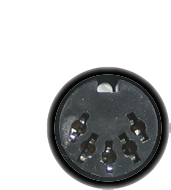Instead of a general purpose board and then small interface circuits for each sensor (a lá Eobody or Miditron) there are 2 slightly specialized boards with differing firmware. This allows the boards to remain small, simple and inexpensive. It also means that its much easier to correctly wire up sensors 'out of the box.'
Here is a list board designs:
- Resistive sensor board. This design contains circuitry for handling resistive-type sensors. For example: bend sensors, pressure sensors, photosensors, etc.
- Analog & digital input. This design contains circuitry for handling pure 'analog' or 'digital' inputs such as from Sharp IR distance sensors, pushbuttons, tilt sensors, switches, potentiometers, etc.
Each board contains the same power supply, microcontroller, MIDI in/out jacks, etc.
Make sure you know which board you have, as they are both designed to do one job very well.
The Resistive sensor board has 6 sensor ports, each of which can be connected to one sensor. The types of sensors it can be used with are the following:
- Photocell / CdS cell / photoresistor
- Bend / Flex sensor
- Force sensitive resistor (FSR) (and other FSR-like sensors)
The Analog/Digital Input & Output (ADio) sensor board has 11 sensor ports (6 analog or digital, 5 digital-only). The types of sensors it can be used with are the following:
- "Sharp" IR distance sensors
- PIR distance sensors
- Mechanical switches & buttons
- Other switches such as magnetic reed or tilt/mercury switches
- Temperature
- Air pressure
- Linear and rotary potentiometers
- Ribbons
- Analog joysticks (2 potentiometers)
- LEDs (PWM output)
- Panel meters (PWM output)
- Small hobby servos (PWM output)
Currently the following are not supported
- Rotary encoders
- Sonar sensors
- Motors
